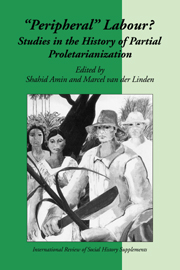Book contents
- Frontmatter
- Contents
- Introduction
- Colonialism, Capitalism and the Discourse of Freedom
- The Barriers to Proletarianization: Bolivian Mine Labour, 1826–1918
- Labour, Ecology and History in a Puerto Rican Plantation Region: “Classic” Rural Proletarians Revisited
- Coal and Colonialism: Production Relations in an Indian Coalfield, c. 1895–1947
- “Capital Spectacles in British Frames”: Capital, Empire and Indian Indentured Migration to the British Caribbean
- Unsettling the Household: Act VI (of 1901) and the Regulation of Women Migrants in Colonial Bengal
- Sordid Class, Dangerous Class? Observations on Parisian Ragpickers and their Cités During the Nineteenth Century
- Notes on Contributors
Coal and Colonialism: Production Relations in an Indian Coalfield, c. 1895–1947
Published online by Cambridge University Press: 14 October 2009
- Frontmatter
- Contents
- Introduction
- Colonialism, Capitalism and the Discourse of Freedom
- The Barriers to Proletarianization: Bolivian Mine Labour, 1826–1918
- Labour, Ecology and History in a Puerto Rican Plantation Region: “Classic” Rural Proletarians Revisited
- Coal and Colonialism: Production Relations in an Indian Coalfield, c. 1895–1947
- “Capital Spectacles in British Frames”: Capital, Empire and Indian Indentured Migration to the British Caribbean
- Unsettling the Household: Act VI (of 1901) and the Regulation of Women Migrants in Colonial Bengal
- Sordid Class, Dangerous Class? Observations on Parisian Ragpickers and their Cités During the Nineteenth Century
- Notes on Contributors
Summary
Introduction
The year 1995 marked the centenary of the exploitation of a 400 square-kilometre tract in the Indian province of Bihar known as the Jharia coalfield. From 1895, when rail lines entered the region, until the end of the World War I, coal output in India increased tenfold and the size of the mines' workforce fivefold. By 1907 Jharia was yielding half of India's output. One of its oldest mines was Khas Jharia, which worked a 260-feet deep source. Thirty-four years after it opened, its surface had merged with the outskirts of Jharia township and restrictions were imposed on the dimensions of its galleries. Despite these, Khas Jharia's pillars collapsed on 8 November 1930 causing an 18-feet deep subsidence and widespread destruction. This incident was the proximate cause of an underground fire which rages to this day.
Emissions and subsidences at Khas Jharia continued, despite efforts by the Mines Department and the railways to douse the seams. In 1933 the flaming crevasses alarmed local residents, many of whom deserted their houses. The Bihar earthquake of 1934 enhanced air circulation in the mine, and by 1938 an observer's first impressions of Jharia town were of fissures belching colourful flames. The disaster was the most notorious example of a general malaise: by 1936, 42 of the 133 collieries in the area were on fire.
These phenomena were the more dramatic ramifications of production relations in the coal industry. Like its other features, they may best be comprehended through a contextual analysis of institutional forms. Such an analysis would have a bearing on matters such as mines safety, the organization of natural resources, and the emergence of an Adivasi (tribal) political estate.
- Type
- Chapter
- Information
- Peripheral LabourStudies in the History of Partial Proletarianization, pp. 83 - 108Publisher: Cambridge University PressPrint publication year: 1997
- 1
- Cited by



